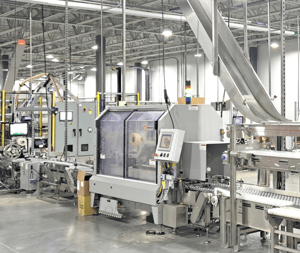 In the fast-paced and dynamic landscape of the material handling industry, the quest for enhanced efficiency and productivity has led to the integration of cutting-edge technologies. One area where significant strides are being made is in the automation of end-of-line operations. These operations, encompassing activities such as sorting, packaging, and palletizing, play a crucial role in ensuring the seamless transition of goods from production to distribution. Embracing automation not only enhances efficiency, but also addresses challenges related to labor shortages, rising operational costs, and the need for accuracy and speed.
In the fast-paced and dynamic landscape of the material handling industry, the quest for enhanced efficiency and productivity has led to the integration of cutting-edge technologies. One area where significant strides are being made is in the automation of end-of-line operations. These operations, encompassing activities such as sorting, packaging, and palletizing, play a crucial role in ensuring the seamless transition of goods from production to distribution. Embracing automation not only enhances efficiency, but also addresses challenges related to labor shortages, rising operational costs, and the need for accuracy and speed.
Traditionally, end-of-line operations in the material handling industry heavily relied on manual labor. While this approach has been effective to some extent, it comes with inherent limitations such as human error, varying levels of productivity, and increased risk of workplace injuries. However, with automation technologies comes opportunity to overcome these challenges and redefine the efficiency standards.
Automation Technologies in Material Handling
Conveyor Systems: Automated conveyor systems have become integral to end-of-line operations. These systems are designed to transport products efficiently, reducing manual handling and minimizing the risk of product damage. Furthermore, conveyor belts can be customized to handle various product sizes and shapes, streamlining the sorting and packaging processes.
Picking Technology Systems: In some cases, these picking systems utilize robotic arms and grippers to pick items from one location and accurately place them in another. They are especially effective in tasks such as packing, where speed and precision are paramount. Machine learning algorithms (i.e. WMS, WCS) enable these systems to adapt to different product variations and optimize the picking process.
Automated Packaging Solutions: Advances in automated packaging technologies contribute significantly to end-of-line efficiency. Automated packaging systems can handle various packaging materials, seal products securely, and even apply labeling utilizing print and apply solutions. This not only speeds up the process, but also reduces the likelihood of errors associated with manual packaging.
Robotics: Robots and robotic systems are increasingly being deployed in end-of-line operations. These technologies can perform a range of tasks, from sorting and picking to packing and palletizing. Equipped with advanced sensors and machine vision, robots can adapt to different products and packaging variations, ensuring precision and consistency.
Benefits of Automation in End-of-Line Operations
Increased Efficiency: Automation eliminates bottlenecks and accelerates the end-of-line processes, resulting in faster throughput and reduced lead times. The continuous operation of automated systems ensures a consistent and reliable output, optimizing overall efficiency.
Enhanced Accuracy and Quality: Automation technologies reduce the margin for human error, leading to improved accuracy in sorting, packaging, and palletizing. Consistent quality control is maintained throughout the process, reducing the likelihood of defects or damaged products.
Cost Savings: While the initial investment can be substantial, the long-term cost savings are significant. Reduced labor costs, increased productivity, and minimized errors contribute to a more cost-effective and streamlined operation.
Adaptability and Scalability: Automated systems can be easily programmed and reconfigured to accommodate changes in product types, sizes, or packaging requirements. This adaptability ensures that end-of-line operations remain efficient even in dynamic manufacturing environments.
As the material handling industry continues to evolve, the integration of automation in end-of-line operations emerges as a pivotal strategy to achieve higher efficiency, accuracy, and cost-effectiveness. Embracing these technologies not only addresses current challenges, but also positions businesses for future growth and adaptability in an ever-changing marketplace. With automation continuously on the rise, end-of-line operations in the material handling industry will keep revolutionizing productivity and driving innovation.
Author: Heather Connors, Director of Marketing, CHC

